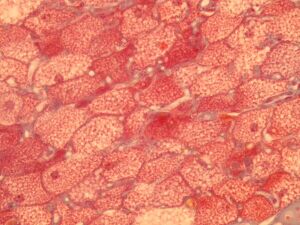Adipose tissue
Adipose tissue is a connective tissue, characterized by the accumulation of fat actively formed from carbohydrates and fatty acids in cells called adipocytes. The process of fat storage and breakdown is controlled by hormonal and neural stimuli. Tissue serves as thermal insulation and energy storage. It is surrounded by reticular connective tissue and blood fibers.
White adipose tissue[edit | edit source]
It is composed of univacuolar adipocytes. The univacuolar adipocyte contains a large adipose vacuole compressing the nucleus at the periphery of the cell. It serves as energy storage, mechanical and thermal insulation. It is located mainly in the subcutaneous tissue. White adipose tissue can be found around the kidneys where it forms the renal capsules. It is also in the omentums or palms and soles, where it forms elastic pads. Under stress, the cells can only deform as far as the reticular ligament will allow them to; when released, they resume their original shape.
Brown adipose tissue[edit | edit source]
Reddish-brown tissue - a color caused by a high number of mitochondria. It is made up of multivacuolar adipocytes, which are adipocytes with multiple tiny vacuoles. The nucleus is located in the centre of the cell. This tissue is richly innervated sympatheticus. It responds more readily to hormonal stimuli than to changes in nutrition (opposite to white matter). Located between the shoulder blades in newborns and along the great vessels. It serves to warm the body when this is not possible for physiological reasons.
Histology[edit | edit source]
Important features of adipocytes are the production of leptinu and the presence of the enzyme aromatase.
In addition to adipose tissue, where neutral fats represent an energy reserve, there is also a higher fat content in other cells:
- Ito cells of the liver - deposits of vitamin A;
- type II pneumocytes, which form surfactants;
- cells of lipid-secreting exocrine glands - sebaceous glands, lactating mammary gland;
- endocrine gland cells synthesizing steroids - adrenal cortex and gonads;
- enterocytes and hepatocytes that synthesize lipoproteins - enterocytes form chylomicrons (Apo-B-48), hepatocytes form VLDL (Apo-B-100).
Physiologically, fat occurs in two forms in the cell:
- structural - membrane phospholipids;
- storage - neutral fats serving as energy stores.
Extracellularly fat can get traumatized in adipose tissue. In this case, it represents a foreign body that gives rise to lipogranulomas or fatty acids may be released during necrosis of adipose tissue by the action of pancreatic lipases.
Lipid presence test[edit | edit source]
In paraffin cuts, the fat is washed while watering and draining. This creates optically empty spaces. The pass is carried out by lipid-soluble dyes
- neutral fats (TAG, cholesterol and its esters) - Sudan III, IV (red), Sudan Black, Oil Red;
- phospholipids - potassium dichromate, Nile blue, OsO4 (for electron microscopy);
- glycolipids - PAS reaction;
- myelin - luxury blue.
Links[edit | edit source]
[edit | edit source]
- Brown adipose tissue (sample)
- White adipose tissue (sample)
- Brown adipose tissue
- Ligaments
- Thermoregulation
Zdroj[edit | edit source]
- LÜLLMANN-RAUCH, Renate. Histologie. 3. edition. Grada Publishing a.s., 2012. 556 pp. ISBN 9788024737294.
- ČIHÁK, Radomír – (PROF.MUDR), Miloš. Anatomie 1. 2. edition. Grada Publishing, spol. s.r.o., 2001. 497 pp. ISBN 9788071699705.
- PASTOR, Jan. Langenbeck's medical web page [online]. [cit. 2015-03-09]. <https://langenbeck.webs.com/>.




